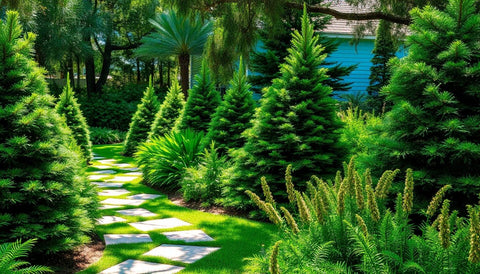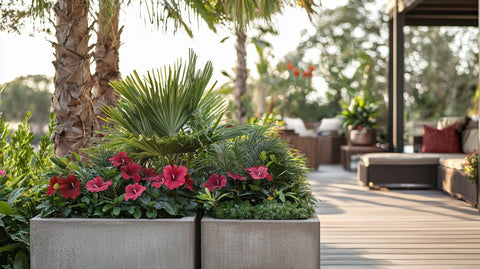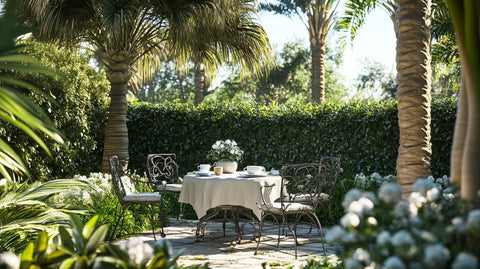Introduction
Florida's rich and diverse ecosystem is home to a stunning array of native plants that bring vibrancy and resilience to any landscape. One of the most rewarding projects for any garden enthusiast in the Sunshine State is incorporating native evergreen shrubs. These versatile plants offer a bounty of benefits, from providing stable greenery and structure to being hardier in local conditions. Their ability to retain foliage year-round makes them a staple in sustainable landscaping.
In this comprehensive guide, we aim to explore some of the most compelling Florida native evergreen shrubs. Whether you're a seasoned gardener or a newcomer to plant care, understanding these plants will enhance your landscape design and promote ecological harmony.

Understanding Evergreen Shrubs
A. Definition and Characteristics
Evergreen shrubs are a classification of plants that maintain their leaves throughout the entire year. Unlike deciduous plants, which shed their leaves seasonally, evergreen varieties have evolved to thrive in stable environmental conditions, making them particularly suitable for Florida's climate.
These shrubs are not only appreciated for their aesthetic year-round greenery but also for their functional roles in gardens, such as providing privacy, windbreaks, and erosion control.
B. Benefits in Florida Gardens
- Climate Adaptation: Native evergreen shrubs are naturally adapted to Florida's climate, requiring less water and maintenance.
- Biodiversity Support: These plants support local wildlife, providing habitats and food sources for Florida's native birds, insects, and small mammals.
- Soil Stability: Their root systems help in stabilizing soil, preventing erosion, especially in coastal and sandy areas.
- Low Maintenance: As they are well-suited to local conditions, evergreen shrubs generally require minimal pest control and fertilization efforts.
Top Florida Native Evergreen Shrubs
A. Coontie (Zamia pumila)
The Coontie is a hardy, native plant known for its fern-like appearance and resilience. This drought-tolerant shrub is perfect for both sunny and shaded areas, making it versatile for various landscape designs.
Coontie serves as a vital component of Florida's ecology by providing food for the rare Atala butterfly. Its unique adaptability makes it suitable for urban settings and natural restorations.
B. Simpson's Stopper (Myrcianthes fragrans)
This delightful, aromatic shrub offers small white flowers and attractive red berries. Simpson's Stopper is notable for its wildlife attraction qualities, as it serves as a food source for birds and pollinators.
Simpson's Stopper is an excellent choice for gardeners interested in crafting hedges or privacy screens that serve both functional and ecological purposes.
C. Firebush (Hamelia patens)
The Firebush dazzles with its vibrant orange-red flowers that persist throughout the year, attracting hummingbirds and butterflies. Its tolerance to heat and drought makes it ideal for xeriscaping in Florida.
You can purchase diverse palm varieties like the Adonidia Palm to complement your Firebush and create a lush tropical ambiance in your garden.

D. Saw Palmetto (Serenoa repens)
Known for its fan-like fronds and medicinal properties, the Saw Palmetto is a staple in Florida's landscape. It offers striking foliage and is especially beneficial in coastal gardens for its salt tolerance.
This shrub's low-growing habit makes it suitable for ground cover applications that can thrive without the need for intense maintenance.
E. Wild Coffee (Psychotria nervosa)
With its shiny leaves and attractive red berries, Wild Coffee is more than just ornamental. This shrub provides nectar for pollinators and fruit for birds, contributing significantly to garden biodiversity.
It thrives under the canopy of larger trees, making it an excellent under-story choice for shaded gardens. Consider pairing it with larger specimens like Alexander Palm for a layered effect.
Design Tips for using Evergreen Shrubs
A. Low Maintenance Garden Design
Leveraging Florida natives reduces the need for intensive gardening efforts. Focus on creating plant zones based on water needs and sunlight exposure to enhance growth and minimize upkeep.
1. Grouping by Water Needs
When designing with evergreen shrubs, consider their water requirements. Group drought-tolerant species like Coontie and Firebush together. For moister zones, use Wild Coffee and Simpson's Stopper.
2. Layering Techniques
Create visual interest by layering heights and textures using various shrubs. Use taller species like Saw Palmetto as background plants, with medium-height shrubs and smaller ground covers in the foreground.
B. Complementary Plant Pairings
- With Palm Varieties: Mix evergreen shrubs with palm trees such as the Adonidia Palm Double for tropical-themed gardens.
- Highlighting Flowers: Pair non-flowering shrubs with flowering plants, like Agapanthus Lily of the Nile, to add splashes of color.
C. Sustainable Landscaping Practices
Implementing sustainable landscape practices enhances the efficacy of using native evergreen shrubs.
1. Mulching
Through mulching, maintain soil moisture and reduce weed growth. It helps in creating an ideal microenvironment for your evergreen shrubs to thrive.
2. Water Efficiency
Incorporate drip irrigation systems for precise watering, ensuring that each plant receives adequate moisture without wastage.

Conclusion: Elevate Your Garden with Evergreen Shrubs
As we've explored, native evergreen shrubs are an invaluable asset to Florida gardens. Their robust nature, ecological benefits, and year-round beauty make them a prime choice for landscapes across the state.
Embrace the native charm of Florida's evergreens and enhance your garden's aesthetics permanently. At Plantology, we're committed to providing you with quality native plants and expert advice for your landscapes. Visit our website to explore our vast selection of evergreen shrubs, palms, and more to invigorate your outdoor spaces.
Whether you're starting a new garden project or refreshing your existing landscape, let us help you make it a thriving, evergreen masterpiece.
``` This format includes structured sections with headings and subheadings, providing both educational content about Florida native evergreen shrubs and subtle promotion of Plantology's products with relevant links. Each section is designed to offer valuable insight into selecting and managing these plants, with CTAs seamlessly integrated into the content. ```htmlDiving Deeper: The Ecological Significance of Native Shrubs
A. Native Shrubs and Wildlife
Native evergreen shrubs in Florida are more than just decorative elements; they are integral parts of the ecosystem, playing critical roles in maintaining biodiversity. These shrubs provide much-needed shelter for various animal species, offering protection against predators and harsh weather conditions.
For example, the dense foliage of the Saw Palmetto (Serenoa repens) offers an ideal nesting site for birds, while the berries of the Firebush (Hamelia patens) serve as an important food source for pollinators like hummingbirds and butterflies, ensuring their sustenance throughout the year. Similarly, the Wild Coffee (Psychotria nervosa) is beloved by songbirds who feed on its ripe berries, facilitating seed dispersal and contributing to pollinator preservation.
B. Contribution to Carbon Sequestration
Trees and shrubs are well-known for their ability to capture and store atmospheric CO2, but evergreen shrubs provide this service in an especially efficient manner. By maintaining foliage year-round, these plants continue photosynthesis without interruption, effectively acting as continual carbon sinks. This is particularly significant in urban and suburban areas where they help to mitigate greenhouse gas emissions.
One might consider designing a garden filled with various species of evergreen shrubs for this benefit. Not only does it contribute to carbon sequestration, but it also aids in reducing household carbon footprints. For homeowners committed to environmental health, native evergreen shrubs present a sustainable solution that requires minimal effort while promising great ecological rewards.

Case Studies: Successful Native Evergreen Shrub Landscapes
A. Urban Residential Landscaping
In urban settings, incorporating native evergreen shrubs into garden designs can transform limited spaces into verdant retreats. For instance, a townhouse in downtown Miami used Coontie (Zamia pumila) and Simpson’s Stopper (Myrcianthes fragrans) to create a lush, low-maintenance patio garden. The selection of these drought-resistant plants allowed the homeowners to minimize their water usage while enjoying a plant-rich environment.
By arranging these shrubs alongside decorative pavers and water features, the space achieved a perfect blend of sustainability and modern aesthetic appeal. Strategically placed Wild Coffee shrubs added depth and texture to the vertical landscape, encouraging visits from local wildlife and injecting dynamics into the small space.
B. Institutional Landscaping
Educational institutions and businesses across Florida have also recognized the importance of using native evergreen shrubs in their landscaping projects. The University of Central Florida campus, for instance, has successfully integrated Firebush and Saw Palmetto into its green spaces as a demonstration of ecological landscaping practices.
These plants not only beautify the environment but also serve as educational tools. Their presence allows students to learn about the practical applications of sustainable practices and the importance of preserving Florida’s natural flora. The shrubs’ role in supporting the campus’s biodiversity, reducing the need for artificial fertilizers and extensive irrigation systems, has also been widely documented, showcasing a commitment to environmental sustainability.
Practical Gardening Tips and Common Challenges
A. Planting and Care
Successfully establishing a native evergreen garden involves a few essential steps that contribute to the health and longevity of the plants. Beginners and seasoned gardeners alike should consider the following when planting:
- Site Preparation: Ensure the planting area is cleared of weeds and debris. For best results, till the soil to improve aeration and drainage.
- Time of Planting: Planting during cooler months is often advantageous as it allows the shrubs to establish roots before the stress of summer heat.
- Initial Watering: While native shrubs are drought-tolerant, adequate watering during the establishment period promotes robust root growth.
- Fertilization: Though native shrubs require minimal fertilization, an occasional application of a balanced, slow-release fertilizer can help maintain vigor.
B. Addressing Pests and Diseases
Native evergreen shrubs are generally resilient against pests and diseases, largely due to their evolutionary adaptation to local conditions. However, occasional issues may still arise. Here’s how to address common challenges:
- Aphids: Occasional aphid infestations can be managed by manually removing affected parts of the plant or using insecticidal soap.
- Leaf Spot: Fungal infections such as leaf spot can occur during humid seasons. To prevent their spread, ensure proper air circulation around plants and remove infected leaves.
- Root Rot: Avoid overwatering and ensure good soil drainage to prevent root rot, a common issue in poorly drained soils.
Conclusion: The Future of Florida’s Garden Landscapes
Florida's push toward sustainable gardening practices continues to gain traction as more individuals and institutions realize the ecological and aesthetic advantages of native evergreen shrubs. Their ability to adapt to local conditions with minimal input makes them valuable allies in creating resilient landscapes.
As this guide emphasizes, planting native evergreens not only beautifies spaces year-round but also underpins the health and biodiversity of our environment. By choosing to incorporate these resilient plants into your garden, you are supporting an ecologically sound initiative that pays dividends far beyond personal satisfaction. From reducing water usage to providing essential habitats for local wildlife, native shrubs serve as a nurturing foundation for the ecosystems in which they grow.
For more inspiration and guidance, or if you're ready to start your own native plant journey, we invite you to explore our resources at Plantology. Whether you’re looking for the perfect combination of trees and shrubs or need expert advice on maintaining a healthy landscape, we are here to support your endeavors every step of the way.
Join us in making Florida’s gardens lush, vibrant, and sustainable.
``` (Note to the user: This continuation maintains the structure established in the initial content, expanding on the ecological significance and practical implementation of native evergreen shrubs. It provides more in-depth insights and broadens the discussion while linking back to ecological principles, ensuring cohesion and thematic continuity throughout the article.)






























Comments (0)
There are no comments for this article. Be the first one to leave a message!